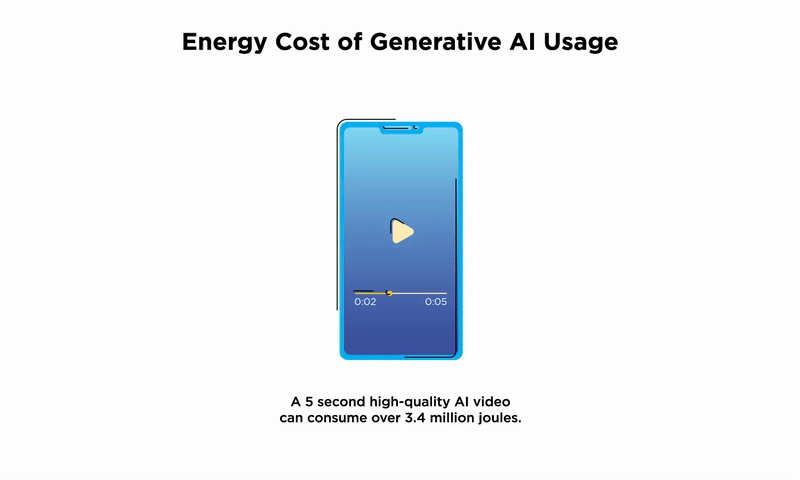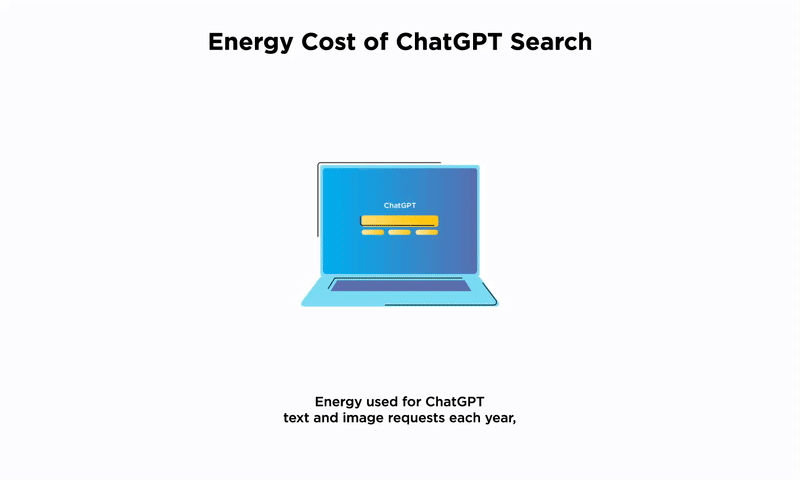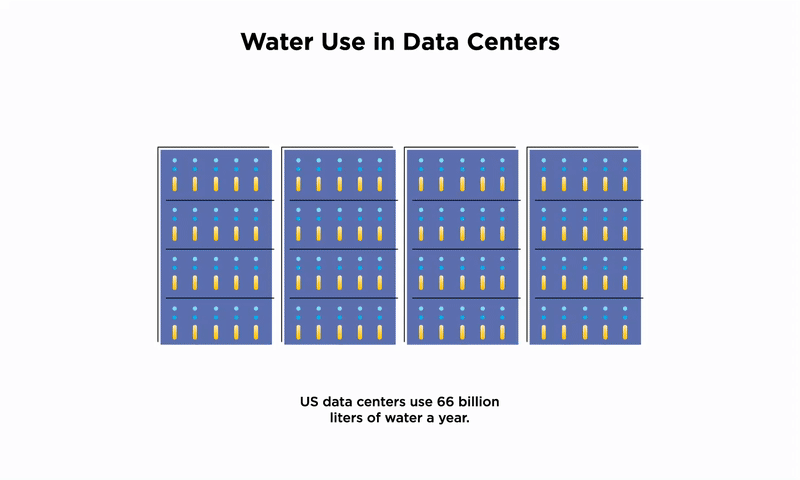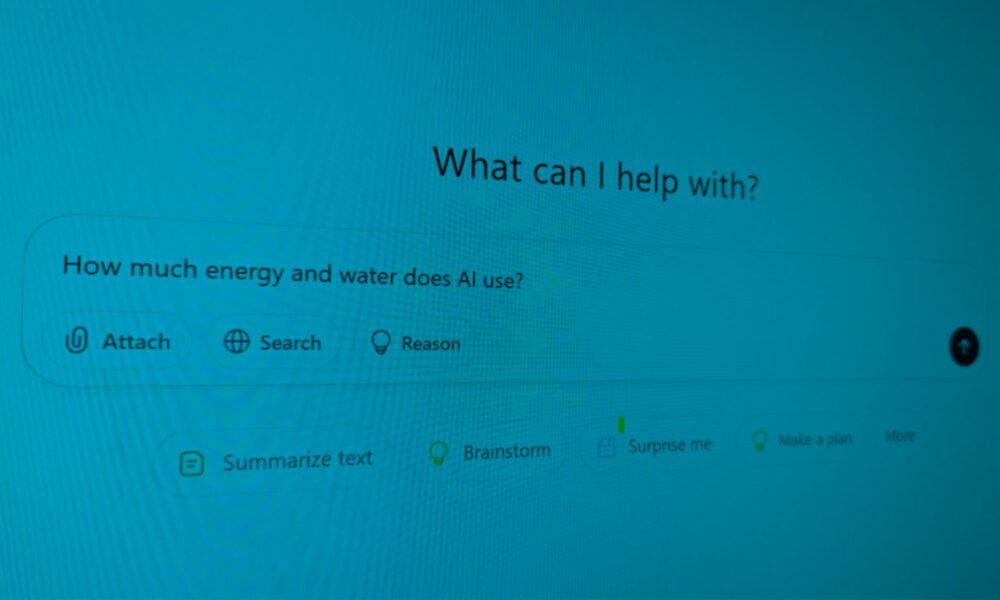While most people think about AI in terms of the apps on their phones or the chatbots they interact with, the real environmental story happens behind the scenes—in massive facilities called data centers. These are the physical buildings filled with thousands of computers that process every AI request. Data centers come in many shapes and sizes, from small server rooms in office buildings to warehouse-sized facilities operated by tech giants like Google, Microsoft, and Amazon.
But the newest generation of data centers, specifically built to handle AI workloads, are fundamentally different from their predecessors. They require far more powerful processors called GPUs (Graphics Processing Units), consume dramatically more electricity, and need significantly more water for cooling. A single AI-focused data center can use as much electricity as a small city and as much water as a large neighborhood.
Generative Artificial Intelligence (GenAI) refers to tools and systems capable of generating text, images, and video. While its use perplexes many people, others react unimpressed by its day-to-day applications or fear its capacity to displace jobs. A recent Pew Research Center report reflects the public and experts’ mixed sentiments, showing that only 17% of people in the United States think AI will have a positive impact within the next 20 years, compared to 56% of experts. In addition, 51% say they are more concerned than excited compared to 17% of experts. One area where both groups agree on is the need for more control and regulation of AI.
One growing conversation in the use or non-use of GenAI is the environmental implications of the technology in every step of its life cycle. Recently, Sam Altman, CEO of OpenAI, suggested that AI’s benefits outweigh its costs. These statements overlook who bears these health and environmental costs, and who gets to decide what trade-offs are acceptable. The communities breathing polluted air near data centers or those experiencing increased energy costs are the ones at the frontline of the technology’s impacts and often last to its benefits.
Sam Altman ends by saying, “Intelligence too cheap to meter is well within grasp.” Implying that AI will become incredibly cheap to produce, so cheap that the cost becomes negligible. ‘Too cheap to meter’ is a quote from 1954 during the early development of nuclear energy, when similar promises were made about electricity costs that ultimately didn’t materialize, but many of its impacts did. Also, didn’t ChatGPT start free, then move to $20 per month for advanced features, with enterprise plans costing hundreds or thousands of dollars? So when Altman talks about intelligence becoming ‘too cheap to meter,’ we have to ask: cheap for whom?
To understand the multiple environmental implications, let’s journey backward through the processes from when a user inputs a prompt into a GenAI tool to when they receive a response in the form of text, an image, or a video. Through this post, I’ll guide you to what I have learned about this topic, from the more well-known implications of artificial intelligence in terms of Energy to other less well-known impacts regarding water use and air pollution.
The energy cost of a ChatGPT request
A user is on their computer and writes a prompt into ChatGPT and clicks send. That request goes to OpenAI servers (the company that created ChatGPT). Servers are located in Data Centers; there are multiple companies that provide data center services, and some of the bigger tech companies like Meta, Google, Amazon, have their own data centers. Data centers are physical buildings with racks of processing units or computers. These units only process the data you input from your device (e.g. personal computer or phone). So, for practical purposes, imagine computers stacked on each other that don’t require a monitor, keyboard, or mouse.
The processing of the prompt happens in Graphics Processing Units (GPUs) and/or Central Processing Units (CPUs). The difference is that GPUs have higher processing power and are more energy-intensive. Most of GenAI requests happen on GPUs regardless of whether your prompt is asking for a text, image, or video response. They acquired their name because they were originally developed to process graphics for video games and other 3D graphics applications. Today they are used for parallel processing, which allows to perform multiple calculations simultaneously. The more “work” a GPU is doing, the more energy it requires. In general, it will take more energy to produce an image, or many images (videos), than text.
To put this in perspective, calculations by O’Donnell and Crownhart in a MIT Technology Review report show that a single query to a small AI text model uses about 114 joules, roughly equivalent to running a microwave for one-tenth of a second. However, larger, more powerful models can use 6,706 joules per response, enough energy to run that same microwave for eight seconds or carry a person 400 feet on an e-bike, according to the report.

The same report estimates that generating a standard-quality image requires about 2,282 joules, while creating a high-quality five-second video can consume over 3.4 million joules—more than 700 times the energy of generating a high-quality image, equivalent to riding 38 miles on an e-bike or running a microwave for over an hour.
Of course, looking at an individual prompt may not seem like much without the context of how many prompts servers get in a day. Estimates are that ChatGPT receives over a billion requests per day for generating text and tens of millions for generating images. According to the same article published in MIT Technology Review, the electricity to process those prompts in one day is equivalent to the power used by over 3,000 homes for a year.

These calculations do not include the energy to generate video and do not include the prompts that other large companies receive through their own AI models, like Microsoft Copilot, Google Gemini, X’s Grok, and other companies developing other AI tools and models.
While many of these calculations have limitations and assumptions that bring uncertainty, what is certain is the observed increase in the electricity that data centers are already using. In 2018, data centers were using 1.9% (76 TWh) of total United States electricity consumed. In 2023, it increased to 4.4% (176 TWh) of the total U.S. electricity consumption and projections to 2028 fall within 6.7% to 12% (300+ TWh to 500+ TWh). All these estimates come from the 2024 United States Data Center Energy Usage Report.
As GPUs are not perfectly efficient, a substantial portion of the energy is turned into heat. That’s where part of the water consumption comes in, to keep those servers cool.
Water use in data centers
Similarly to your phone or computer, the servers processing AI tool requests get hot and release heat into the room. Hot environments can damage electronic components or reduce their efficiency. To cool the servers and data center facilities, there are multiple methods. Air conditioning systems require massive amounts of electricity but use little water, while water-based cooling methods are often preferred because they are cheaper. The cooling happens through machines known as Computer Room Air Handlers (CRAH). In short, these machines take the hot air that rises inside the room, cool it, and return it to the bottom of the room.

How does this work?
Inside the machines there are coils with chilled water. The hot air transfers heat to the water, cooling the air in the process. The outcome is hotter water that needs to be chilled again. The hot water goes to cooling towers where part of the water is evaporated–that’s where the high water use happens. When water evaporates, it absorbs energy in the form of heat, decreasing the temperature of the remaining water, that becomes cooler. Freshwater needs to replace the water that was evaporated. According to a recent report by Lawrence Berkeley National Laboratory, U.S. data centers consumed 66 billion liters of water directly at their facilities (also known as direct water) in 2023.
While 66 billion liters sounds significant–and it is–whether this represents a large amount depends on what we compare it to. If you compare it with water use for agriculture, for example, then it would arguably not be too much water. 66 billion liters convert to 53,507 acre-feet, a measure of water use in agriculture and you can think of each acre-foot as the area of one football field filled with one foot of water. I live in California’s Central Valley, where I can compare this to the water use of almond trees (5 acre-feet per acre of almonds per year in the southern part of the Valley). That would mean that with the water used by all data centers in the United States you could irrigate 11,101 acres of almonds. In California there are about 1.56 million acres of almonds. If we compare it to residential water use, then 66 billion liters is equivalent to the water use of over half a million people in one year.
As a water expert with a PhD in hydrology and having worked on water and climate change for over 10 years, there are other concerns I have. One is that this is showing a dramatically growing trend. According to the same report from Lawrence Berkeley National Laboratory, the direct water used by data centers in 2014 was 21.2 billion liters. So, in the course of 10 years, the water use tripled and data centers are growing in number and size.
The other big concern is that those numbers only reflect direct water use by data centers. It does not include other water uses in the life cycle of artificial intelligence, such as water use for the extraction and manufacture of resources for both the building itself and the hardware and microchips that form the processing units. And it also doesn’t account for indirect water use by the power plants that produce the electricity for data centers, estimated to be 800 billion liters in 2023, over 10 times the direct water use.
Further, these comparisons don’t tell the whole story, because half of the data centers are located in regions where water is already scarce. Data centers strategically position themselves near population centers and in areas with lower electricity costs, but this also means they frequently compete with local communities and agriculture for limited water resources, particularly in drought-prone regions such as California, Arizona, and parts of Texas.
Data centers also contribute to air pollution and degradation of health
The energy consumed by data centers doesn’t just contribute to carbon emissions—it also generates air pollution that directly harms human health. Throughout AI’s lifecycle, from chip manufacturing to data center operation, significant amounts of criteria air pollutants are released into the atmosphere, including fine particulate matter (PM2.5), nitrogen dioxide (NO2), and sulfur dioxide (SO2).
A recent paper by Han et al. at UC Riverside and Caltech titled The Unpaid Toll: Quantifying the Public Health Impact of AI quantifies the public health impacts through the lifecycle of AI. They estimate the public health burden of U.S. data centers in 2030 to be valued at more than $20 billion per year, comparable to emissions by on-road vehicles in California. The cost comes from the increases of the asthma cases and other cardio-pulmonary diseases caused by poor air quality.
These pollutants come from three main sources. First, data centers rely on diesel backup generators for emergency power, which emit substantial amounts of air pollutants during operation, testing, and maintenance. Second, the electricity powering data centers often comes from fossil fuel power plants that release air pollutants when burning coal and natural gas. Third, the manufacturing of AI hardware (requiring highly refined materials) and materials to build data center buildings (iron for steel and resources for cement) generates significant air pollution.
As with other cases of environmental justice, these health impacts are not distributed equally. The air pollutants can travel hundreds of miles from their sources, but the communities most affected are often low-income areas that receive little economic benefit from data centers.
Take action: Learn more
Understanding AI’s environmental implications is crucial for being more mindful about its use and for asking representatives to design and implement appropriate policies and regulations. We need policies that require community engagement from the planning stages, mandate environmental protections, encourage transparent and accessible information from technology developers, and ensure that the benefits of technological advancement are shared equitably.
I had the pleasure of collaborating with a group of outstandingly smart, mindful, and talented students from the Computer Science and Mathematics majors at Harvey Mudd College and Scripps College. Our collaboration culminated in an educational website about Artificial Intelligence and its implications for energy and water. I invite you to explore the interactive elements, and share it with others who might be interested in learning more about the hidden environmental costs of artificial intelligence.

